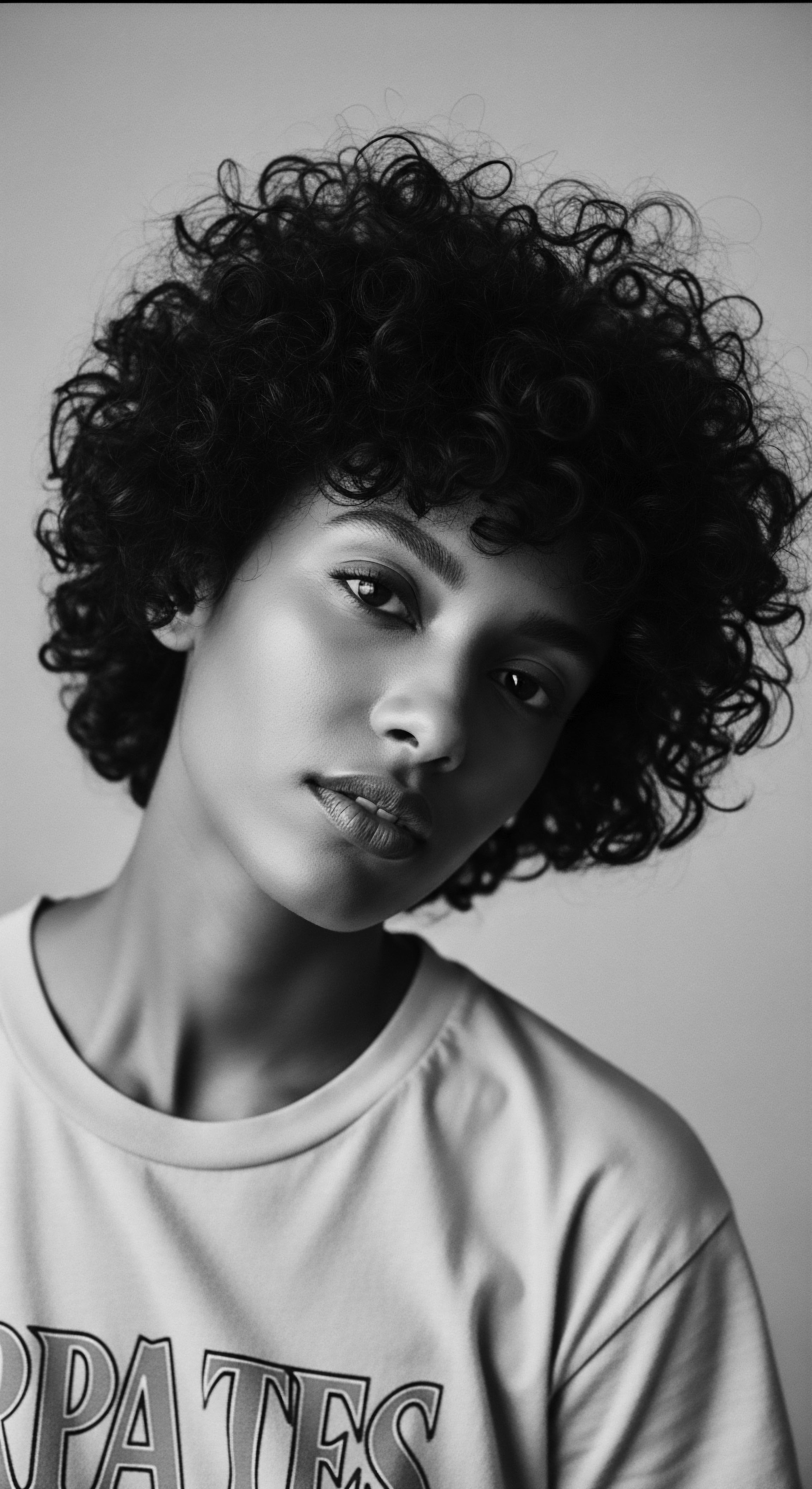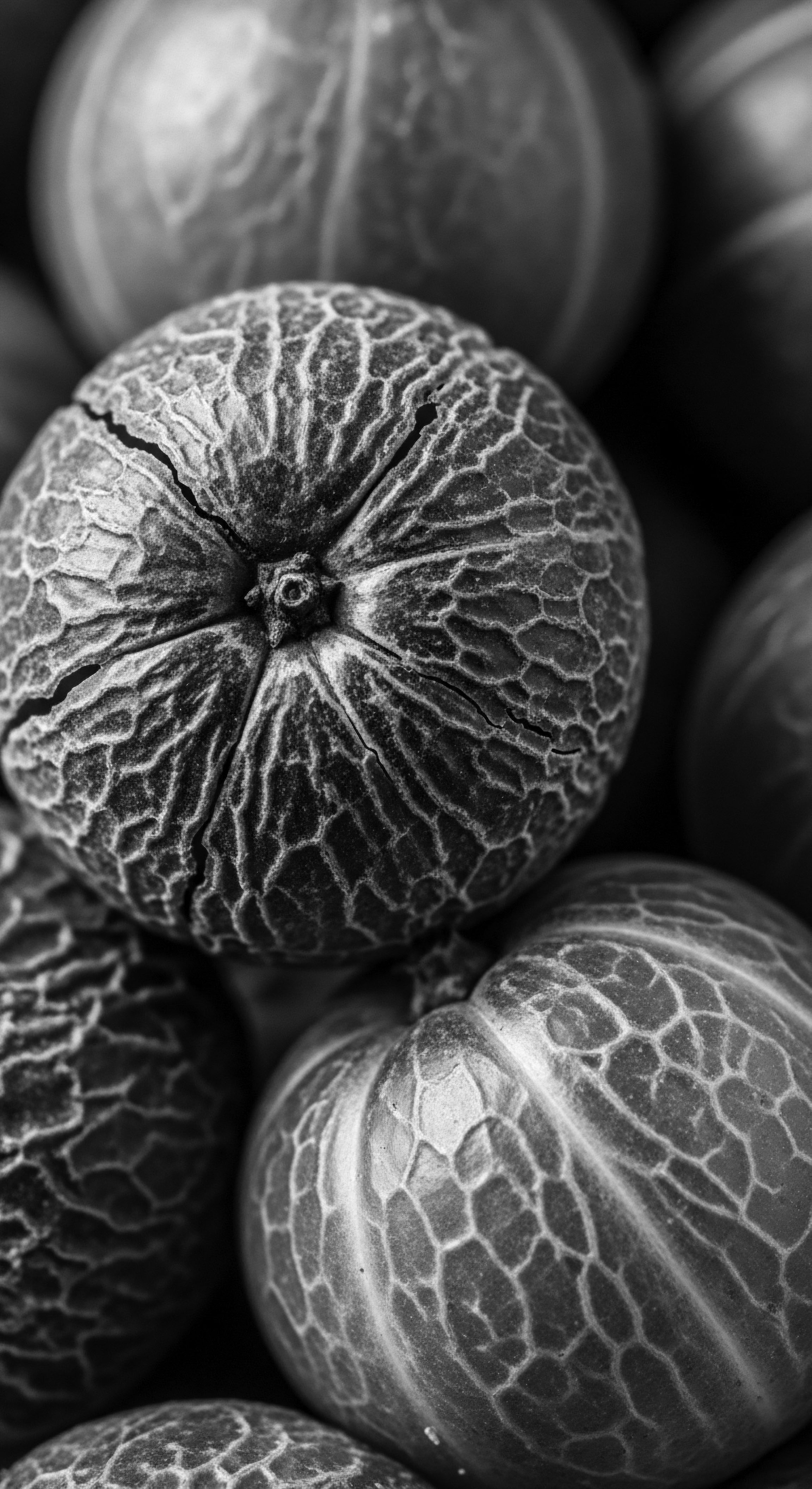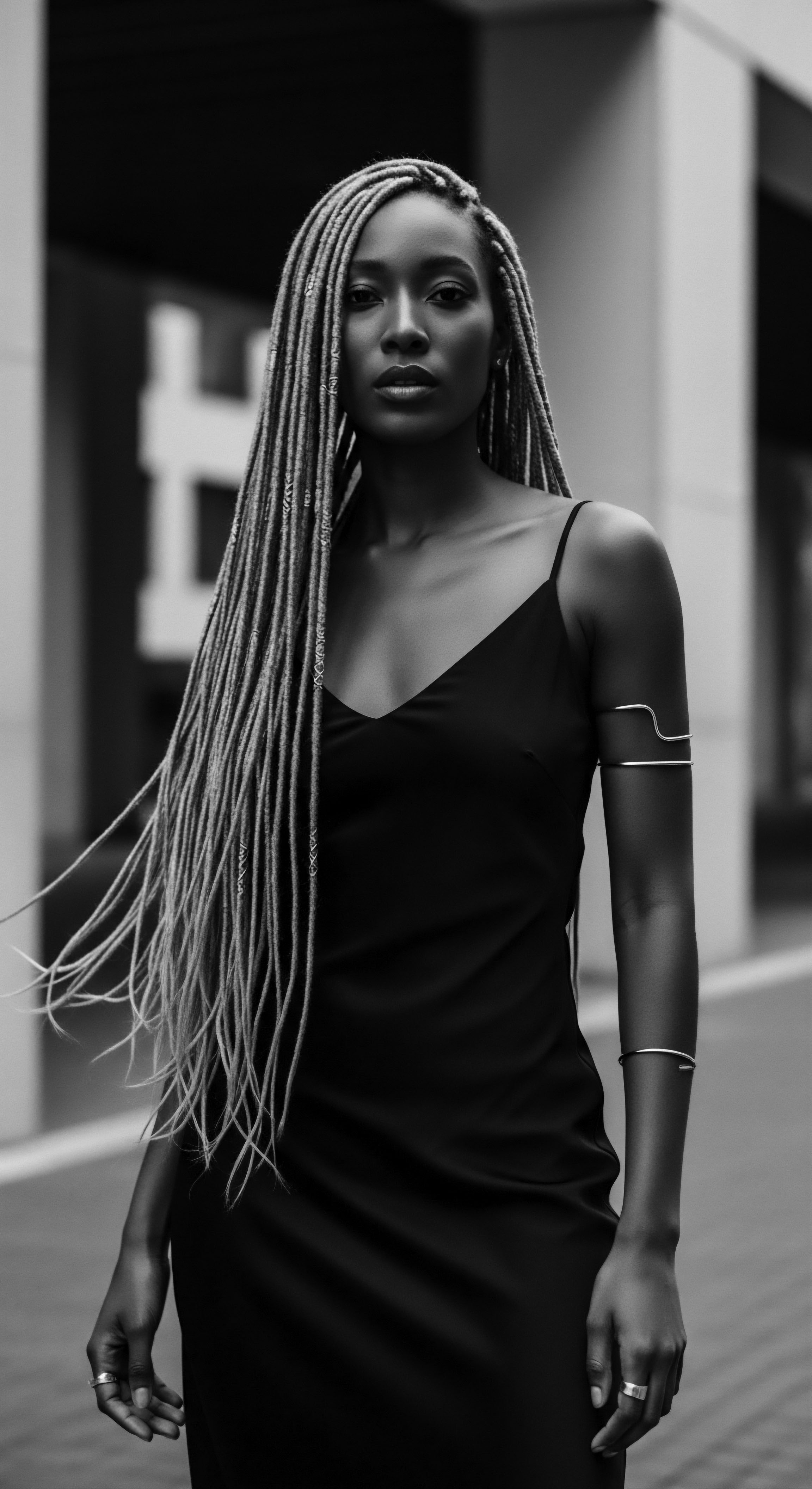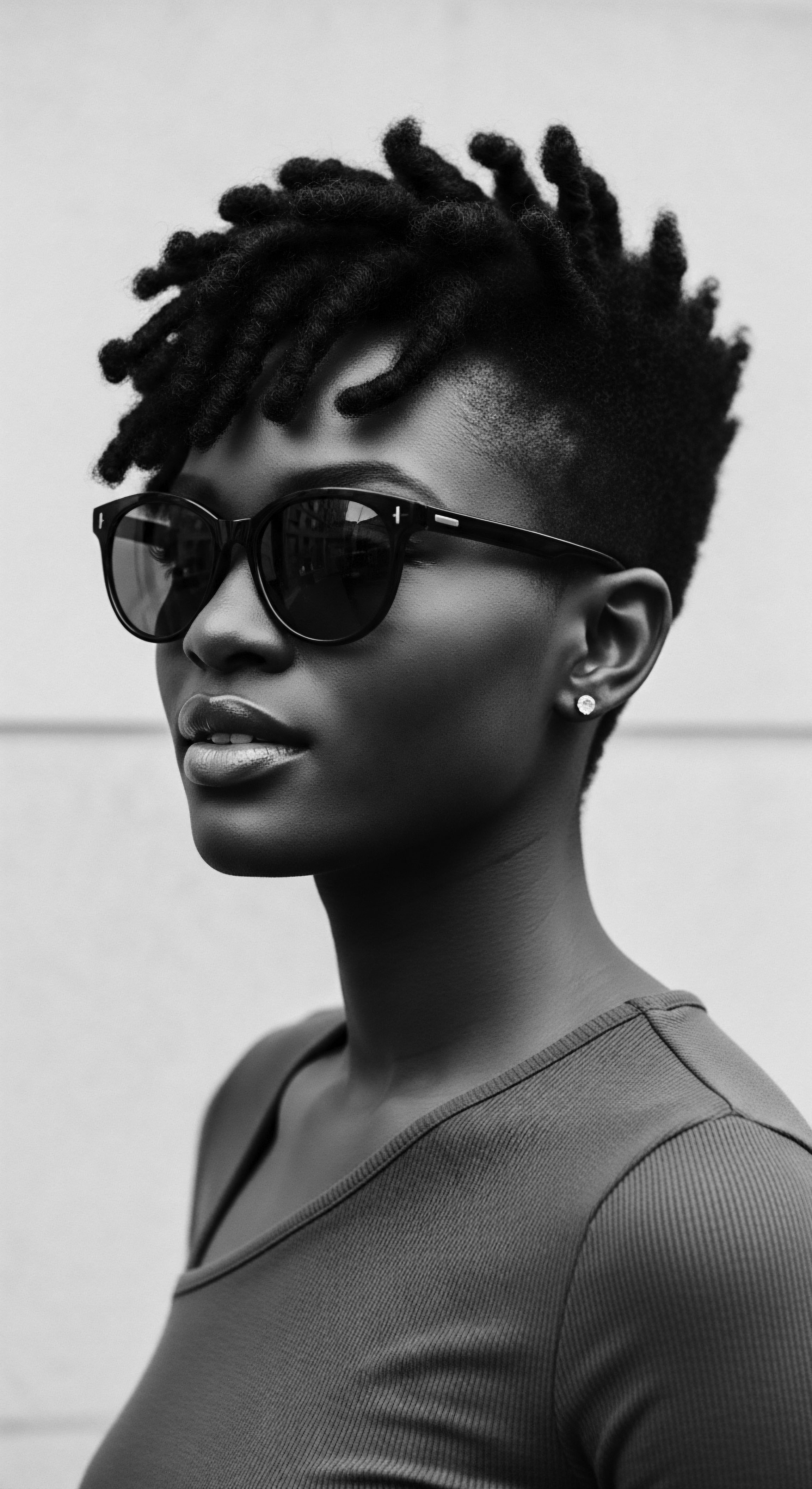
Roots
The story of textured hair is an ancient scripture, etched not just in strands, but in the earth itself, in the very botanicals that sustained ancestral communities. At the heart of this enduring narrative, particularly for Black and mixed-race lineages, lies the humble yet profoundly powerful shea butter. This golden balm, extracted from the nuts of the African shea tree, the Vitellaria paradoxa, has always been more than a simple emolient. It is a generational bridge, a testament to inherited wisdom, connecting the elemental biology of the hair fiber to the collective soul of a people.
From the sun-drenched savannas where the shea tree flourishes, indigenous communities developed a deep understanding of its properties. This knowledge, passed down through oral traditions and hands-on practices, predates any formal scientific inquiry. They knew the butter’s capacity to guard against harsh environmental elements, to soothe, and to maintain the pliability of the hair. This deep knowing, a blend of observation and ancestral insight, laid the very foundation for how textured hair has been perceived and cared for across millennia.

What is the Historical Significance of Shea Butter in Hair Care?
For centuries, perhaps even millennia, the harvesting and processing of shea nuts were communal rites, predominantly performed by women. These were not merely tasks; they were cultural expressions, binding communities and ensuring the continuity of practices that sustained life and vitality. The shea tree itself held spiritual reverence in many cultures, its longevity and resilience mirroring the qualities cherished in the people it served. The butter, thus, became imbued with this sacred status, making its application a ritual act, not simply a cosmetic one.
Consider the Mali Empire, a vast and prosperous civilization where trade routes crisscrossed the continent. Shea butter was a valuable commodity, exchanged for other goods, its reputation for healing and beauty extending far beyond its places of origin. This exchange disseminated knowledge of its uses, further cementing its role in diverse West African hair traditions. Its application transcended simple conditioning; it was a sealant against dust, a shield against sun, and a balm for scalp and strand, guarding against breakage and maintaining length in coils and curls often vulnerable to dryness.
Shea butter, from its very source, embodies a deep ancestral memory of care, a golden link between the earth’s giving spirit and the inherent strength of textured hair.
The unique composition of shea butter—rich in fatty acids, particularly oleic and stearic acids, along with vitamins A and E—made it an ideal natural resource for the needs of textured hair. These complex structures, from the tightly coiled z-patterns to the more open s-patterns, often experience challenges with moisture retention due to their helical structure and the way natural oils traverse the fiber. Ancestral wisdom intuitively understood this need for external lubrication and protection, even without the modern scientific language to articulate it.
| Traditional Application Protective Sealant |
| Observed Benefit for Textured Hair Shielded strands from environmental stressors, reducing breakage. |
| Traditional Application Scalp Invigoration |
| Observed Benefit for Textured Hair Soothed dryness and irritation, promoting a balanced scalp environment. |
| Traditional Application Softening Agent |
| Observed Benefit for Textured Hair Imparted a pliable quality to kinky and coily textures, aiding detangling. |
| Traditional Application Style Foundation |
| Observed Benefit for Textured Hair Provided hold and luster for intricate braids and twists, maintaining form. |
| Traditional Application These traditional uses highlight an innate understanding of textured hair's needs, passed down through generations. |
The foundational understanding of shea butter, born from intimate observation of nature and the human body, created a legacy of hair care. It wasn’t about imposing external ideals, rather about honoring the hair’s natural inclinations. The preparation of the butter, from cracking the nuts to roasting, grinding, and kneading, transformed a raw botanical into a potent elixir. This painstaking process further connected the user to the source, solidifying shea butter’s inherent value within the cultural framework of hair maintenance.
- Karité ❉ The French term for shea, reflecting its widespread use and recognition beyond West Africa.
- Shíyè ❉ The indigenous name in some parts of the Yoruba language, signifying its deep cultural roots.
- Butyrospermum Parkii ❉ The botanical classification, though ancestral knowledge far predates scientific naming.
The wisdom embedded in these practices predates any laboratory analysis. The ancestral custodians of this knowledge understood, through touch and generational observation, the nourishing qualities of the butter. This primal bond with shea butter, woven into the very fabric of daily life, established a heritage of textured hair care that emphasizes sustenance, defense, and reverence for the hair’s own living nature.

Ritual
Beyond its elemental origins, shea butter finds its true voice within the living traditions, the tender threads of care and communal expression that define textured hair heritage. Hair styling, for countless generations across the African diaspora, has never been a mere aesthetic choice. It is a language, a chronicle, a spiritual practice. Shea butter became a silent, yet ever-present, partner in these intricate expressions, enhancing not only the visual beauty but also the health and longevity of the styles.
The very act of preparing hair for braiding, twisting, or cornrowing often involved warming a portion of shea butter between the palms, allowing its creamy richness to melt into a translucent oil. This softened butter was then carefully worked into sections of hair, providing slip for easier manipulation, reducing friction during the styling process, and offering a protective layer against environmental stressors. This wasn’t merely a utilitarian step; it was a moment of connection, often shared between mothers and daughters, sisters and friends, elders and apprentices. These interactions, centered around the application of shea, formed an intrinsic part of the hair ritual.

How Has Shea Butter Influenced Traditional Styling?
Traditional African hairstyles, from elaborate cornrow patterns signifying tribal identity to intricate Bantu knots symbolizing status, demanded pliable, well-conditioned hair. Shea butter provided the necessary lubricity, making the hair fibers more cooperative for intricate shaping. Its inherent fatty acids created a barrier that slowed moisture loss, a crucial function for styles meant to last for days or weeks.
This characteristic was particularly vital in climates where sun and wind could quickly desiccate unprotected strands. The preservation of these styles, enabled in part by shea butter, allowed for the storytelling and social communication inherent in hair artistry to persist.
One powerful illustration of this practical and cultural integration comes from the practice of hair sculpting among the Mangbetu women of what is now the Democratic Republic of Congo. Their elaborate fan-shaped coiffures, often stretched over wicker frameworks, required immense care and frequent conditioning to maintain. Shea butter, alongside other local botanical oils, was meticulously applied to keep the hair healthy, pliable, and lustrous. This historical example underscores how shea butter wasn’t just a product; it was an active agent in preserving and extending the life of complex cultural hair expressions, allowing them to remain symbols of beauty and status for longer periods (Thompson, 2001).
The careful application of shea butter transformed hair styling into a shared moment, a tactile transmission of knowledge and affection across generations.
The migration of African people, particularly during the transatlantic slave trade, carried these traditions, and the memory of shea butter, across oceans. Despite the brutal disruption of their lives, the ancestral knowledge of hair care, including the use of familiar botanicals where available, endured. In new lands, often deprived of the original shea trees, the quest for similar emollients continued. Yet, the foundational methods, the nurturing touch, and the very concept of protective styling as a means of preservation and identity, which shea butter had facilitated for centuries, persisted.
Modern natural hair care movements, particularly within Black and mixed-race communities, have seen a resurgence of ancestral practices, with shea butter standing as a pillar. The “LOC” method (Liquid, Oil, Cream), a popular layering technique for moisturizing textured hair, often uses shea butter as the “Cream” component. This technique, though given a contemporary acronym, echoes the layering approaches found in traditional African hair rituals, where water, light oils, and heavier butters were applied to seal moisture. It shows a cyclical return to what ancestral wisdom always understood about the hair’s needs.
- Twisting ❉ A technique using shea butter to define and protect coils, creating elegant, elongated spirals.
- Braiding ❉ Essential for cornrows and box braids, where shea butter provides grip and reduces frizz for lasting styles.
- Loc Cultivation ❉ Shea butter helps maintain moisture and pliability in locs, guarding against breakage and maintaining their structural integrity.
The tools may have evolved, from bone combs to plastic ones, but the spirit of care remains. The tender touch of hands working butter into strands, whether for a child’s first cornrows or an adult’s sophisticated updo, carries the resonance of countless ancestors. This ritualistic application of shea butter is a reaffirmation of the hair’s intrinsic beauty, a quiet act of defiance against a world that often sought to erase it. It is an affirmation of heritage, communicated not through words, but through the enduring language of touch and tradition.

Relay
The ongoing relay of shea butter’s legacy within textured hair care represents a profound dialogue between the ancestral and the contemporary, a continuous stream of wisdom that shapes identity and future pathways. This isn’t a static history; it is a living, breathing archive, constantly adapting while holding fast to its core truths. The journey of shea butter, from village hearths to global markets, is a testament to its unparalleled efficacy and its deep cultural resonance, particularly for those whose hair embodies the varied helix of Black and mixed-race lineages.
For individuals with textured hair, particularly those navigating the complexities of racial identity in post-colonial contexts, shea butter became more than just a hair product. It stood as a symbol, a tangible link to an African past often fragmented or demonized. Choosing shea butter, alongside other traditional ingredients, represents a deliberate act of reclaiming heritage, an affirmation of self that extends beyond mere aesthetics into the realm of cultural and personal autonomy. This choice is a statement, a gentle declaration of connection to roots.

How Does Ancestral Wisdom Inform Modern Hair Care?
Modern scientific inquiry, often coming full circle, now validates many of the intuitions held by ancestral practitioners. The understanding of the lipid barrier function of the skin and hair, for instance, mirrors the ancient wisdom of using rich butters to seal moisture. Shea butter’s high concentration of unsaponifiable matter, a unique component not found in many other vegetable oils, means it resists saponification (turning into soap) and retains its powerful emollient qualities even after processing. This biochemical distinction explains its lasting protective benefits, a fact long understood by those who applied it to guard against dryness and environmental damage.
One area where this bridge between past and present is particularly clear is in the realm of hair porosity. Textured hair often exhibits variations in porosity, affecting its ability to absorb and retain moisture. Ancestral practices involving layering lighter and heavier oils, culminating in shea butter as a sealant, intuitively addressed these concerns.
The heavier consistency and film-forming properties of shea butter make it exceptionally suitable for low to medium porosity hair, creating a gentle barrier that helps hold hydration within the hair shaft without causing excessive buildup. This holistic understanding, deeply rooted in centuries of observation, now finds articulation in modern trichological terms.
The socio-cultural impact of shea butter in hair care extends to the rise of independent Black-owned beauty brands. These enterprises, often founded on principles of ancestral wisdom and natural ingredients, have championed shea butter as a star component. Their success reflects a consumer base actively seeking products that honor their hair heritage, prioritize health over fleeting trends, and support businesses that understand their unique needs. This economic dimension further strengthens the legacy of shea butter, turning an ancient commodity into a driver of cultural affirmation and self-determination within the beauty industry.
The journey from the shea tree to the myriad hair products available today is a complex one, fraught with considerations of sustainability, ethical sourcing, and fair trade. As demand grows, ensuring that the communities who have stewarded this resource for generations benefit equitably remains a central concern. This contemporary challenge reinforces the need to approach shea butter not just as an ingredient, but as a cultural endowment, deserving of respect and mindful stewardship. Its presence in our daily regimens calls for a deeper reflection on global interconnectedness and the preservation of traditional knowledge.
| Heritage Aspect Communal Ritual |
| Modern Application/Validation Shared natural hair practices in online communities and salons. |
| Heritage Aspect Protective Styling |
| Modern Application/Validation Foundation for L.O.C./L.C.O. methods and long-term protective styles. |
| Heritage Aspect Emollient for Dryness |
| Modern Application/Validation Scientifically recognized occlusive properties for moisture retention. |
| Heritage Aspect Symbol of Self-Acceptance |
| Modern Application/Validation Key ingredient in brands championing natural, textured hair beauty. |
| Heritage Aspect Shea butter bridges ancient practices with contemporary needs, always serving as a constant thread in textured hair's story. |
The enduring presence of shea butter in textured hair care is more than a tradition; it is a vital, dynamic force. It consistently reminds us that true innovation often lies in returning to the wisdom of the past, in honoring the gifts of the earth, and in listening to the whispers of our ancestors. Its consistent use in varied products and practices across the diaspora confirms its status, not as a trend, but as an irreplaceable element in the ongoing narrative of textured hair, a golden fiber woven into the very soul of a strand.

Reflection
The golden essence of shea butter, extracted from the heart of the African landscape, has done more than merely condition coils and curls; it has inscribed itself into the very memory of textured hair. Its journey, from the hands of ancestral gatherers to its contemporary place in self-care routines, is a vivid demonstration of continuity and quiet resilience. This is a story that speaks not just of chemistry and botanical properties, but of the deep human yearning for connection—to the earth, to community, and to the enduring spirit of one’s own heritage. Shea butter, in its tender, nourishing presence, helps us remember, helps us honor, and helps us carry forward the sacred legacy of hair that speaks volumes without a single uttered word.

References
- Thompson, R. (2001). Face of the Gods ❉ Art and Altars of Africa and the African Americas. Prestel Publishing.
- Frank, P. W. (2005). African Ethnobotany. CRC Press.
- Opoku-Nsiah, A. (2009). Traditional Hair Care Practices in Ghana. University of Ghana Press.
- Boateng, L. (2018). The Shea Butter Revolution ❉ From Tree to Transformative Beauty. Black Botanicals Publishing.
- Kaboré, A. (2012). Shea ❉ A Golden Gift from Africa. Self-Published.
